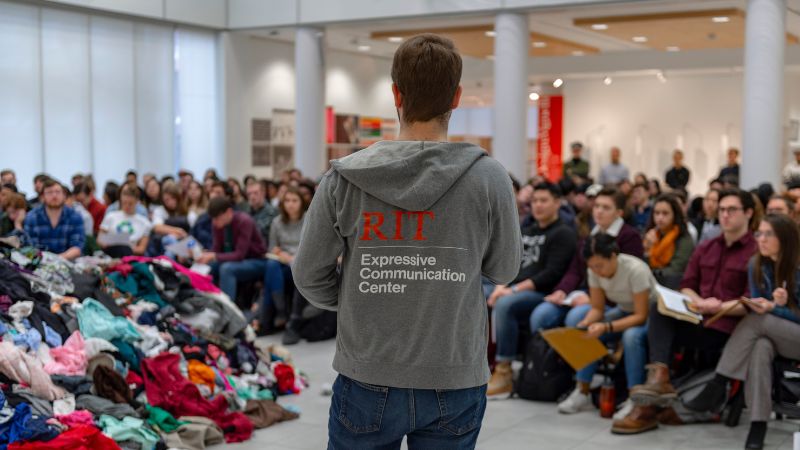Advertising and Public Relations Immersion
- RIT /
- Rochester Institute of Technology /
- Academics /
- Advertising and Public Relations Immersion
Overview for Advertising and Public Relations Immersion
The advertising and public relations immersion provides opportunities for the advanced study of selected areas central to the persuasive arts as they apply to advertising and public relations, as well as education and practice in the writing, speaking, and design skills required of these professions.
Notes about this immersion:
- This immersion is closed to students majoring in advertising and public relations or communication.
- Students are required to complete at least one course at the 300-level or above as part of the immersion.
The plan code for Advertising and Public Relations Immersion is ADVPUB-IM.
Curriculum for 2023-2024 for Advertising and Public Relations Immersion
Current Students: See Curriculum Requirements
| Course | |
|---|---|
| Required Course | |
| Choose one of the following: | |
| COMM-211 | Principles of Advertising An introduction to principles and practices of advertising. Topics include advertising theories, ethics, regulation, consumer research, media planning, message strategy, and campaign planning strategy. Lecture 3 (Fall, Spring). |
| COMM-212 | Public Relations An introduction to the practice of public relations. Topics include history, research areas, laws, ethics, and social responsibilities as they relate to the theory and practice of public relations. Lecture 3 (Fall, Spring). |
| Electives | |
| Choose two of the following: | |
| COMM-202 | Mass Communications The history and development of U.S. media, theoretical aspects of mass communications, the composition of media audiences, law and regulation of mass communications and how the media affect and are affected by society are presented. Lecture 3 (Fall, Spring, Summer). |
| COMM-211 | Principles of Advertising An introduction to principles and practices of advertising. Topics include advertising theories, ethics, regulation, consumer research, media planning, message strategy, and campaign planning strategy. Lecture 3 (Fall, Spring). |
| COMM-212 | Public Relations An introduction to the practice of public relations. Topics include history, research areas, laws, ethics, and social responsibilities as they relate to the theory and practice of public relations. Lecture 3 (Fall, Spring). |
| COMM-221 | Public Relations Writing This course covers a variety of forms of writing for public relations, including news releases, newsletters, backgrounders, public service announcements, magazine queries, interviews, coverage memos, media alerts, features, trade press releases, and public presentations. Students will write for a variety of media including print, broadcast, and the web. Lecture 3 (Fall, Spring). |
| COMM-303 | Small Group Communication This course provides students with opportunities to engage in small group decision making and problem solving. Students will analyze and evaluate their own experiences and relate them to theories and research from the field of small group communication. Lecture 3 (Fall or Spring). |
| COMM-305 | Persuasion An in-depth study of the theories, practices, effects, and ethics of persuasion. Persuasion is defined as human communication designed to influence one’s beliefs, values, attitudes, and actions. This course examines persuasion from a receiver-oriented perspective with interpersonal, small group, organizational, and mediated perspectives. Lecture 3 (Fall, Spring, Summer). |
| COMM-321 | Copywriting and Visualization An opportunity for undergraduates to learn the verbal and visual skills utilized in the creation of advertising messages. To create an effective strategy for an advertising campaign, the advertising copywriter/art director team needs to combine linguistic and visual metaphors into a persuasive message. Students will develop creative advertising messages by researching and writing a creative brief and then implementing the plan by transforming concepts into actual advertising messages and campaigns. (Prerequisites: COMM-211 or equivalent course.) Lecture 3 (Fall, Spring). |
| COMM-322 | Campaign Management and Planning This course introduces students to the managing and planning of advertising and public relations campaigns. It takes a team project approach thereby helping students learn how to work together in class as well as in a competitive agency. Service-learning will be used to expose students to community causes. (Prerequisites: COMM-211 and COMM-212 or equivalent courses.) Lecture 3 (Fall, Spring). |
| COMM-341 | Visual Communication This course is an introduction to the study of visual communication. The iconic and symbolic demonstration of visual images used in a variety of media is stressed. The major goal of the course is to examine visual messages as a form of intentional communication that seeks to inform, persuade, and entertain specific target audiences. Lecture 3 (Fall or Spring). |
| COMM-346 | Global Media An introduction to media technologies from a global perspective. Major theories about the media, current trends in media, journalism practices, and governmental challenges and restrictions are reviewed. Students will use various media technologies both locally and abroad through site visits, readings, and online resources resulting in a media production (mini-documentary, movie trailer, and/or international film review). Special focus on the growing importance of the internet and digital media on news flow, advertising, and entertainment. Lec/Lab 3 (Fall or Spring). |
| COMM-356 | Critical Practice in Social Media With the advent of virtual communities, smart mobs, and online social networks, questions about the meaning of human communication and how we construct our online and offline personal and professional identities need to be reevaluated. This course explores the relationship between social media and the construction of both individual and social identities as well as best practices for constructing the desired community or identity. Although the course is grounded in theory, it is equally committed to practice, and much of the class discussion and activity takes place in various online spaces. As a practicum, those who complete this course will know how to engage productively in practices such as tweeting, blogging, tagging, etc. and will develop an understanding of how these practices affect their construction of identity and community both personally and on behalf of an organization. Lecture 3 (Fall, Spring). |
* At least one course must be taken at the 300-level or above.













